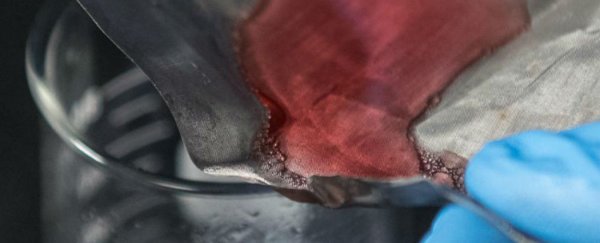Researchers in the US have developed a new type of stainless steel mesh that attracts and traps oil but lets water pass through. In lab tests using mixtures of oil and water, all the researchers needed to do was collect the oil on top of the mesh, and tip it into a beaker for disposal. The special oil-repelling coating on the mesh caused the oil to bead up and roll exactly where they need it to go. Easy.
"If you scale this up, you could potentially catch an oil spill with a net," lead researcher and mechanical engineer Bharat Bhushan, from Ohio State University, said in a press release.
The team got the idea from how a lotus leaf functions - or rather, how it doesn't function. Thanks to a specialised series of bumps on the surface of the leaves, the lotus plant is able to perfectly repel water, but not heavier, stickier drops of oil. Bhushan's team needed to do the opposite, so mimicked this bumpy surface texture by spraying drops of silica nanoparticles onto a piece of stainless steel mesh.
"Nature reaches a limit of what it can do," said one of the team, Philip Brown. "To repel synthetic materials like oils, we need to bring in another level of chemistry that nature doesn't have access to."
The team then coated this bumpy surface in an oil-repelling substance made from polymer molecules embedded with surfactants - compounds that are he commonly used active ingredients in detergents, soaps, emulsifiers, and foaming agents. And they watched as the mesh perfectly separated oil molecules from water molecules.
Sounds incredibly simple, right? Well, it certainly wasn't easy figuring out the right combination of bumps and repellents, as the team describes in two separate papers in the journal Scientific Reports. (You can find them here and here.) Over the past decade, they've discovered that certain combinations of the bumpy and oil-repelling layers can actually produce nanoparticles that would bind to the oil instead of repelling it, and even the minuscule shape of the nanoparticles had to be taken into account, as they could affect the way the oil was repelled.
What's really promising about this new mesh is that it's made from non-toxic, fairly cheap, and readily available materials, and the team says a large portion of the mesh could be produced for around a dollar per square foot.
 Credit: Ohio State University
Credit: Ohio State University
Another benefit is how incredibly thin and unobtrusive the whole thing is. Because the bumpy coating is just a few hundred nanometres (or a few billionths of a metre) thick, you can barely feel it. The team have gotten the coating to 70 percent transparency, and are now working on 90 percent transparency, so it could potentially be used on windows to make them smudge-free. Because let's face it - while cleaning up oil spills is the most worthwhile application for this, giving it a marketable application could see some good money put behind it.
"Our goal is to reach a transparency in the 90-percent range," said Bhushan in the release. "In all our coatings, different combinations of ingredients in the layers yield different properties. The trick is to select the right layers."
The team is also now exploring the possibility of replacing the silica nanoparticles with tiny nanotubes - about a thousand times smaller than a single human hair - made from a compound called molybdenum disulfide. This chemical is known to bind well with oil, which means it could make the mesh capture oil modules more effectively.
"There are natural defects in the structure of the nanotubes," said one of the team, Dave Maharaj. "And under high loads, the defects cause the layers of the tubes to peel apart and create a slippery surface, which greatly reduces friction."
You can watch them discuss the technology below:
